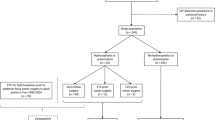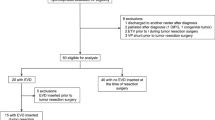Abstract
Object
Most pediatric patients that present with a posterior fossa tumor have concurrent hydrocephalus. There is significant debate over the best management strategy of hydrocephalus in this situation. The objectives of this paper were to review the pathophysiology model of posterior fossa tumor hydrocephalus, describe the individual risks factors of persistent hydrocephalus, and discuss the current management options. Specifically, the debate over preresection cerebrospinal fluid diversion is discussed.
Results
Only 10–40 % demonstrate persistent hydrocephalus after posterior fossa tumor resection. It appears that young age, moderate to severe hydrocephalus, transependymal edema, the presence of cerebral metastases, and tumor pathology (medulloblastoma and ependymoma) on presentation predict postresection or persistent hydrocephalus. The Canadian Preoperative Prediction Rule for Hydrocephalus (CPPRH), a validated prediction model, can be used to stratify patients at point of first contact into high and low risk for persistent hydrocephalus.
Conclusions
A protocol is proposed for managing hydrocephalus that utilizes the CPPRH. Low-risk patients can be monitored conservatively with or without an intraoperative extraventricular drain, while high-risk patients require the use of an intraoperative extraventricular drain, higher postoperative hydrocephalus surveillance, and even consideration for a preoperative endoscopic third ventriculostomy.
Similar content being viewed by others
References
Bognár L, Borgulya G, Benke P, Madarassy G (2003) Analysis of CSF shunting procedure requirement in children with posterior fossa tumors. Childs Nerv Syst 19:332–336. doi:10.1007/s00381-003-0745-x
Culley DJ, Berger MS, Shaw D, Geyer R (1994) An analysis of factors determining the need for ventriculoperitoneal shunts after posterior fossa tumor surgery in children. Neurosurgery 34:402–407, discussion 407–8
Bhatia R, Tahir M, Chandler CL (2009) The management of hydrocephalus in children with posterior fossa tumours: the role of pre-resectional endoscopic third ventriculostomy. Pediatr Neurosurg 45:186–191. doi:10.1159/000222668
Ruggiero C, Cinalli G, Spennato P et al (2004) Endoscopic third ventriculostomy in the treatment of hydrocephalus in posterior fossa tumors in children. Childs Nerv Syst 20:828–833. doi:10.1007/s00381-004-0938-y
Raimondi AJ, Tomita T (1981) Hydrocephalus and infratentorial tumors. Incidence, clinical picture, and treatment. J Neurosurg 55:174–182. doi:10.3171/jns.1981.55.2.0174
Albright L, Reigel DH (1977) Management of hydrocephalus secondary to posterior fossa tumors. J Neurosurg 46:52–55. doi:10.3171/jns.1977.46.1.0052
Schneider C, Ramaswamy V, Kulkarni AV et al. (2014) Clinical implications of medulloblastoma subgroups: incidence of CSF diversion surgery. J Neurosurg Pediatr 1–7. doi: 10.3171/2014.9.PEDS14280
Foreman P, McClugage S, Naftel R et al (2013) Validation and modification of a predictive model of postresection hydrocephalus in pediatric patients with posterior fossa tumors. J Neurosurg Pediatr 12:220–226. doi:10.3171/2013.5.PEDS1371
Riva-Cambrin J, Detsky AS, Lamberti-Pasculli M et al (2009) Predicting postresection hydrocephalus in pediatric patients with posterior fossa tumors. J Neurosurg Pediatr 3:378–385. doi:10.3171/2009.1.PEDS08298
Morelli D, Pirotte B, Lubansu A et al (2005) Persistent hydrocephalus after early surgical management of posterior fossa tumors in children: is routine preoperative endoscopic third ventriculostomy justified? J Neurosurg 103:247–252. doi:10.3171/ped.2005.103.3.0247
Gnanalingham KK, Lafuente J, Thompson D et al (2003) The natural history of ventriculomegaly and tonsillar herniation in children with posterior fossa tumours—an MRI study. Pediatr Neurosurg 39:246–253
Sainte-Rose C, Cinalli G, Roux FE et al (2001) Management of hydrocephalus in pediatric patients with posterior fossa tumors: the role of endoscopic third ventriculostomy. J Neurosurg 95:791–797. doi:10.3171/jns.2001.95.5.0791
Kumar V, Phipps K, Harkness W, Hayward RD (1996) Ventriculo-peritoneal shunt requirement in children with posterior fossa tumours: an 11-year audit. Br J Neurosurg 10:467–470
Lee M, Wisoff JH, Abbott R et al (1994) Management of hydrocephalus in children with medulloblastoma: prognostic factors for shunting. Pediatr Neurosurg 20:240–247
Dias MS, Albright AL (1989) Management of hydrocephalus complicating childhood posterior fossa tumors. Pediatr Neurosci 15:283–289, discussion 290
Schmid UD, Seiler RW (1986) Management of obstructive hydrocephalus secondary to posterior fossa tumors by steroids and subcutaneous ventricular catheter reservoir. J Neurosurg 65:649–653. doi:10.3171/jns.1986.65.5.0649
Papo I, Caruselli G, Luongo A (1982) External ventricular drainage in the management of posterior fossa tumors in children and adolescents. Neurosurgery 10:13–15
Tamburrini G, Pettorini BL, Massimi L et al (2008) Endoscopic third ventriculostomy: the best option in the treatment of persistent hydrocephalus after posterior cranial fossa tumour removal? Childs Nerv Syst 24:1405–1412. doi:10.1007/s00381-008-0699-0
Schijman E, Peter JC, Rekate HL et al (2004) Management of hydrocephalus in posterior fossa tumors: how, what, when? Childs Nerv Syst 20:192–194. doi:10.1007/s00381-003-0900-4
Stein BM, Tenner MS, Fraser RA (1972) Hydrocephalus following removal of cerebellar astrocytomas in children. J Neurosurg 36:763–768. doi:10.3171/jns.1972.36.6.0763
Abraham J, Chandy J (1963) Ventriculo-atrial shunt in the management of posterior-fossa tumours: preliminary report. J Neurosurg 20:252–253. doi:10.3171/jns.1963.20.3.0252
Hekmatpanah J, Mullan S (1967) Ventriculo-caval shunt in the management of posterior fossa tumors. J Neurosurg 26:609–613. doi:10.3171/jns.1967.26.6.0609
Jane JA, Kaufman B, Nulsen F et al (1973) The role of angiography and ventriculovenous shunting in the treatment of posterior fossa tumors. Acta Neurochir (Wien) 28:13–27
Hemmer R, Haensel-Friedrich G, Friedrich H (1976) The value of preoperative shunts in posterior fossa tumors. Mod Probl Paediatr 18:48–50
Goel A (1993) Whither preoperative shunts for posterior fossa tumours? Br J Neurosurg 7:395–399
Tuli S, Tuli J, Drake J, Spears J (2004) Predictors of death in pediatric patients requiring cerebrospinal fluid shunts. J Neurosurg 100:442–446. doi:10.3171/ped.2004.100.5.0442
Drake JM, Kestle JRW, Milner R et al (1998) Randomized trial of cerebrospinal fluid shunt valve design in pediatric hydrocephalus. Neurosurgery 43:294
Cochrane DD, Kestle JRW (2003) The influence of surgical operative experience on the duration of first ventriculoperitoneal shunt function and infection. Pediatr Neurosurg 38:295–301. doi:10.1159/000070413
McLaurin RL (1983) Disadvantages of the preoperative shunt in posterior fossa tumors. Clin Neurosurg 30:286–292
Taylor WA, Todd NV, Leighton SE (1992) CSF drainage in patients with posterior fossa tumours. Acta Neurochir (Wien) 117:1–6
El-Gaidi MA, El-Nasr AHA, Eissa EM (2015) Infratentorial complications following preresection CSF diversion in children with posterior fossa tumors. J Neurosurg Pediatr 15:4–11. doi:10.3171/2014.8.PEDS14146
Santhanam R, Balasubramaniam A, Chandramouli BA (2009) Fatal intratumoral hemorrhage in posterior fossa tumors following ventriculoperitoneal shunt. J Clin Neurosci 16:135–137. doi:10.1016/j.jocn.2008.02.016
Waga S, Shimizu T, Shimosaka S, Tochio H (1981) Intratumoral hemorrhage after a ventriculoperitoneal shunting procedure. Neurosurgery 9:249–252
Epstein F, Murali R (1978) Pediatric posterior fossa tumors: hazards of the “preoperative” shunt. Neurosurgery 3:348–350
Zuccarello M, Dollo C, Carollo C (1985) Spontaneous intratumoral hemorrhage after ventriculoperitoneal shunting. Neurosurgery 16:245–246
Kleinman GM, Hochberg FH, Richardson EP (1981) Systemic metastases from medulloblastoma: report of two cases and review of the literature. Cancer 48:2296–2309
Hoffman HJ, Hendrick EB, Humphreys RP (1976) Metastasis via ventriculoperitoneal shunt in patients with medulloblastoma. J Neurosurg 44:562–566. doi:10.3171/jns.1976.44.5.0562
Oberbauer RW, Tritthart H, Ascher PW et al (1979) Shunt metastases in posterior fossa tumors. Neuropadiatrie 10:296–300. doi:10.1055/s-0028-1085332
Jamjoom ZA, Jamjoom AB, Sulaiman AH et al (1993) Systemic metastasis of medulloblastoma through ventriculoperitoneal shunt: report of a case and critical analysis of the literature. Surg Neurol 40:403–410
Berger MS, Baumeister B, Geyer JR et al (1991) The risks of metastases from shunting in children with primary central nervous system tumors. J Neurosurg 74:872–877. doi:10.3171/jns.1991.74.6.0872
El-Ghandour NMF (2010) Endoscopic third ventriculostomy versus ventriculoperitoneal shunt in the treatment of obstructive hydrocephalus due to posterior fossa tumors in children. Childs Nerv Syst 27:117–126. doi:10.1007/s00381-010-1263-2
Di Rocco F, Jucá CE, Zerah M, Sainte-Rose C (2013) Endoscopic third ventriculostomy and posterior fossa tumors. WNEU 79:S18.e15–S18.e19. doi: 10.1016/j.wneu.2012.02.018
Bouras T, Sgouros S (2011) Complications of endoscopic third ventriculostomy. J Neurosurg Pediatr 7:643–649. doi:10.3171/2011.4.PEDS10503
Tamburrini G, Frassanito P, Bianchi F et al. (2014) Closure of endoscopic third ventriculostomy after surgery for posterior cranial fossa tumor: the “snow globe effect.” Br J Neurosurg 1–4. doi: 10.3109/02688697.2014.987214
Kulkarni AV, Drake JM, Mallucci CL et al (2009) Endoscopic third ventriculostomy in the treatment of childhood hydrocephalus. J Pediatr 155:254–259.e1. doi:10.1016/j.jpeds.2009.02.048
Drake JM, Canadian Pediatric Neurosurgery Study Group (2007) Endoscopic third ventriculostomy in pediatric patients: the Canadian experience. Neurosurgery 60:881–886. doi:10.1227/01.NEU.0000255420.78431.E7, discussion 881–6
Rappaport ZH, Shalit MN (1989) Perioperative external ventricular drainage in obstructive hydrocephalus secondary to infratentorial brain tumours. Acta Neurochir (Wien) 96:118–121
Richard KE, Frowein RA, Vanner GK (1976) Ventricular fluid pressure in posterior fossa tumors of childhood. Mod Probl Paediatr 18:35–39
Vaquero J, Cabezudo JM, de Sola RG, Nombela L (1981) Intratumoral hemorrhage in posterior fossa tumors after ventricular drainage. Report of two cases. J Neurosurg 54:406–408. doi:10.3171/jns.1981.54.3.0406
Tamburrini G, Massimi L, Caldarelli M, Di Rocco C (2008) Antibiotic impregnated external ventricular drainage and third ventriculostomy in the management of hydrocephalus associated with posterior cranial fossa tumours. Acta Neurochir (Wien) 150:1049–1056. doi:10.1007/s00701-008-0022-6
Conflict of interest
None of the authors have any conflicts of interest associated with this publication.
Author information
Authors and Affiliations
Corresponding author
Rights and permissions
About this article
Cite this article
Lin, CT., Riva-Cambrin, J.K. Management of posterior fossa tumors and hydrocephalus in children: a review. Childs Nerv Syst 31, 1781–1789 (2015). https://doi.org/10.1007/s00381-015-2781-8
Received:
Accepted:
Published:
Issue Date:
DOI: https://doi.org/10.1007/s00381-015-2781-8




